In this post I have explained a few circuit concepts which can be employed for converting or modifying any ordinary square wave inverter to sophisticated sine wave inverter design.
Before studying the various designs I have explained in this article, it would be interesting to know the factors which typically makes a sine wave inverter more desirable than a square wave design.
How Frequency Works in Inverters
Inverters basically involve frequency or oscillations for implementing the boost and inversion actions. The frequency as we know is generation of pulses at some uniform and calculated pattern, for example a typical inverter frequency may be rated at 50Hz or 50 positive pulses per second.
The fundamental frequency waveform of an inverter is in the form of square wave pulses.
As we all know a square wave is never suitable for operating sophisticated electronic equipment such as TV, music players, computers etc.
The AC (alternating current) mains that we acquire at our domestic mains outlet also consists of pulsating current frequency, but these are in the form of sinusoidal waves or sine waves.
It's normally at 50Hz or 60Hz depending upon the particular country utility specs.
The above mentioned sine curve of our home AC waveform refers to the exponentially rising voltage peaks which constitute the 50 cycles of the frequency.
Since our domestic AC is generated through magnetic turbines, the wave form is inherently a sine wave, so doesn't require any processing further and becomes directly usable in homes for all types of appliances.
Conversely in inverters, the fundamental waveform are in the shape of square waves which needs thorough processing in order to make the unit compatible with all types of equipment.
Difference between Square Wave and Sine Wave
As shown in the figure, a square wave and sine wave may have identical peak voltage levels but the RMS value or the root mean square value may not be identical. This aspect is what that makes a square wave particularly different from a sine wave even though the peak value may be the same.
Therefore a square wave inverter working with 12V DC would generate an output equivalent to say 330V just like a sine wave inverter operating with the same battery but if you measure the output RMS of both the inverters, it would differ significantly (330V and 220V).
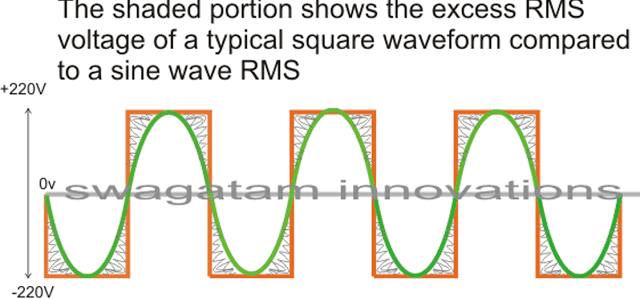
The image incorrectly shows 220V as the peak, actually it should be 330V
In the above diagram, the green colored waveform is the sine waveform, while the orange depicts the square waveform. The shaded portion is the excess RMS which needs to be leveled of in order to make both the RMS values as close as possible.
Converting a square wave inverter into a sine wave equivalent thus basically means allowing the square wave inverer to produce the required peak value of say 330V yet having an RMS just about equal to its sine wave counterpart.
How to Convert/Modify a Square Waveform to Sine Waveform Equivalent
This can be done either by carving a square wave sample into a sine wave form, or simply by chopping a sample square waveform into well calculated smaller pieces such that its RMS becomes very close to a standard mains AC RMS value.
For carving a square wave to a perfect sine wave, we can employ a wien bridge oscillator or more precisely a "bubba oscillator" and feed it to a sine wave processor stage. This method would be too complex and is therefore not a recommended idea for implementing an existing square wave inverter to a sine wave inverter.
The more feasible idea would be to chop the associated square wave at the base of the output devices to the required RMS degree.
One classic example is shown below:
The first diagram shows an square wave inverter circuit. By adding a simple AMV chopper we can break down the pulses at the base of the relevant mosfets to the required degree.
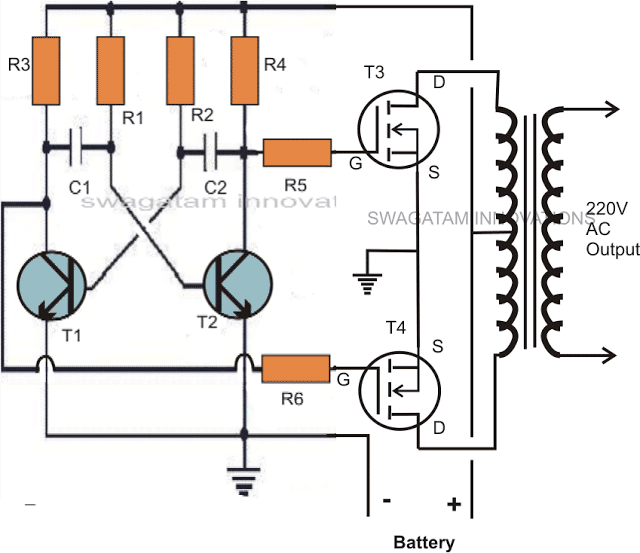
Modified square wave to sine wave equivalent inverter version of the above circuit.
Here the lower AMV generate pulses at high frequency whose mark/space ratio can be suitably altered with the help of preset VR1. This PWM controlled output is applied to the gates of the mosfets in order to tailor their conduction into the stipulated RMS value.
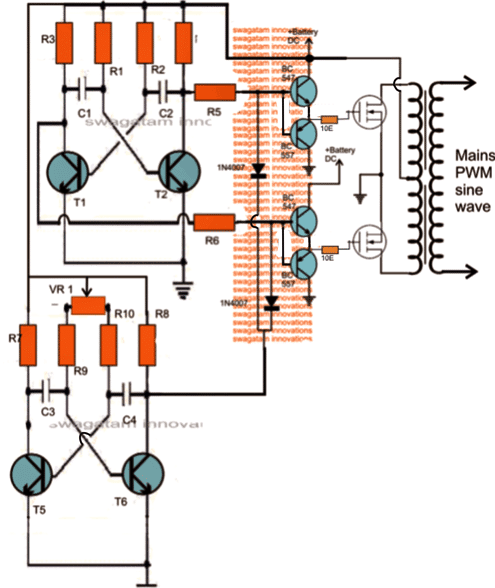
Expected typical waveform pattern from the above modification:
Waveform at the mosfet gates:
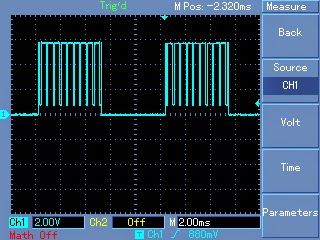
Waveform at the output of transformer:
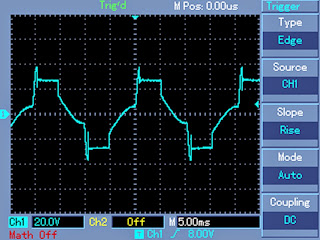
Waveform after proper filtration using inductors and capacitors at the output of the transformer:
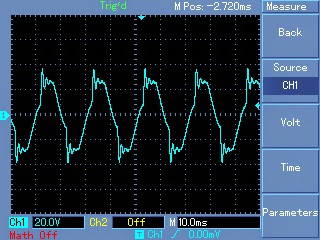
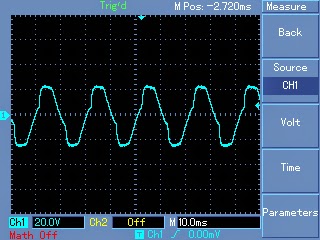
Parts List
R1, R2, = 27K,
R3, R4, R5, R6, R7,R8, R9, R10 = 1K Ohms,
C1,C2 = 0.47uF/100V metallized
C3, C4 = 0.1uF
T1, T2, T5, T6 = BC547,
T3, T4 = any 30V, 10amp mosfet, N-channel.
D1, D2 = 1N4148
VR1 = 47K preset
Transformer = 9-0-9V, 8 amp (specifications must be selected as per the output load for correct powre optimization)
Battery = 12V,10AH
Getting Better Efficiency Rate
The above explained conversion or modification will provide around 70% of efficiency with the achieved RMS matching. If you are interested in getting better and precise matching then probably a an IC 556 PWM waveform processor would be required.
You would want to refer to this article which shows the principle behind modifying a square waveform into a sine waveform using a couple of IC555.
The output from the above mentioned circuit can be similarly fed to the gate or the base of the relevant power devices which are present in the existing square inverter unit.
A more comprehensive approach may be witnessed in the this article where an IC 556 is used for extracting precise PWM based modified sine wave equivalents from a square wave sample source.
This waveform is integrated with the existing output devices for implementing the intended modifications.
The above examples teach us the simpler methods through which any existing ordinary square wave inverter may be modified into a sine wave inverter designs.
Converting into an SPWM
In the above article I have explained how the waveform of a square wave inverter could be optimized for getting a sine wave kind of waveform by chopping the square wave into smaller sections.
However a deeper analysis shows that unless the chopped waveform is not dimensioned in the form of SPWMs, achieving a proper sinewave equivalent may not be possible.
To satisfy this condition an SPWM converter circuit becomes essential for carving out the most ideal sinewaveform from the inverter.
The basic idea is to chop the output power devices with sine wave pulse width modulation, so that the power devices force the transformer winding to also oscillate in the SPWM mode and ultimately generate an optimized pure sine wave at the secondary side. The magnetic induction of the pulsed SPWM across the transformer winding finally gets the shape of a pure sine wave due to the inductive filtration of the transformer winding.
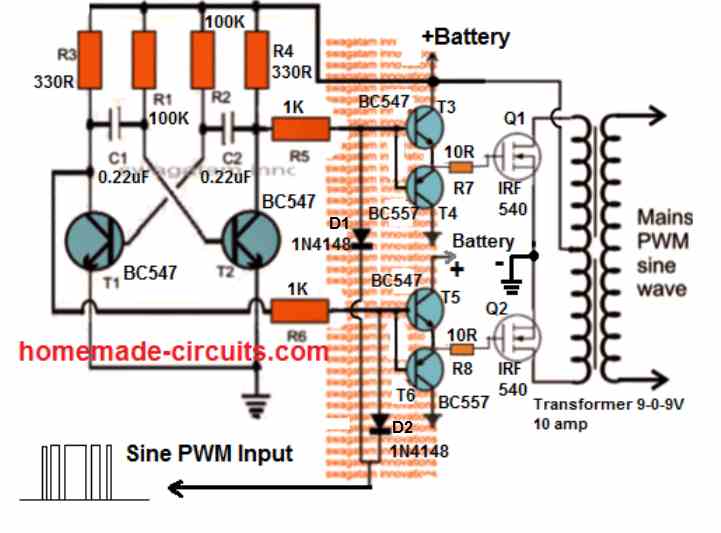
The following diagram shows how this could be effectively implemented with the concept discussed above.
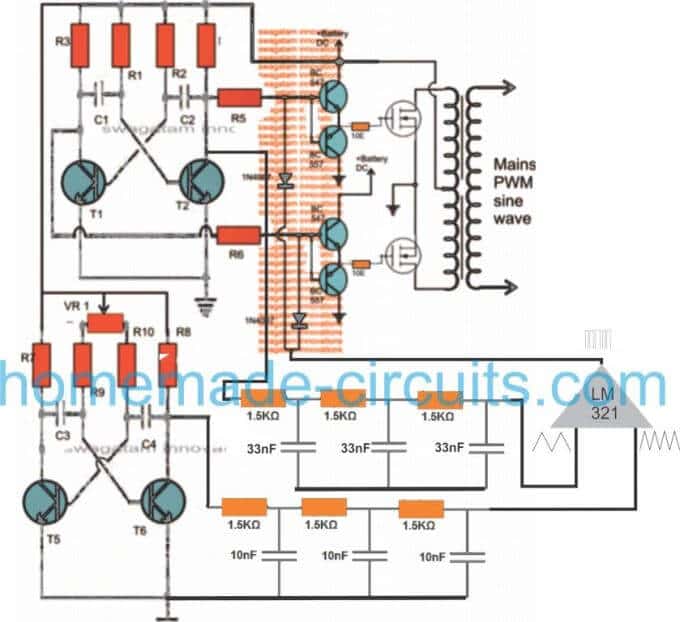
Through one of my earlier articles we understood how an opamp could be used for creating SPWMs, the same theory could be seen applied in the above concept. Two triangle wave generators are used here, one accepting the fast square wave from the lower astable, while the other accepting slow square waves from the upper astable and processing them into corresponding fast and slow triangle wave outputs, respectively.
These processed triangle wave are fed across the two inputs of an opamp, which finally converts them into SPWMs or sine wave pulse widths.
These SPWMs are used for chopping the signals at the gate of the mosfets which ultimately switch the waveform over the connected transformer winding for creating an exact replica of a pure sine waveform at the secondary side of the transformer through magnetic induction.
How to Calculate the Part Values
Astable Multivibrator Frequency (Square Waves):
Formula: f = 1 / (0.693 * (R1 + 2 * R2) * C)
For the fast square wave generator:
Let R1 = 10k ohms, R2 = 100k ohms, C = 10nF (example values).
ffast = 1 / (0.693 * (10000 + 2 * 100000) * 10e-9)
ffast = 1 / (0.693 * 210000 * 10e-9)
ffast = 68 Hz
For the slow square wave generator:
Let R1 = 10k ohms, R2 = 1M ohm, C = 100nF (example values).
fslow = 1 / (0.693 * (10000 + 2 * 1000000) * 100e-9)
fslow = 1 / (0.693 * 2010000 * 100e-9)
fslow = 7.1 Hz
RC Integrator Cutoff Frequency (Triangle Wave Generators):
Formula: fc = 1 / (2 * π * R * C)
For each RC stage assume R = 1.5k ohms and C = 33nF.
fcstage = 1 / (2 * 3.1416 * 1500 * 33e-9)
fcstage = 1 / (2 * 3.1416 * 0.0000495)
fcstage = 3223 Hz
For three stages the overall response rolls off steeply approximately at the same fcstage.
Op-Amp SPWM Generation:
The op-amp compares the fast triangle wave (carrier) and the slow triangle wave (modulating signal). The output is high when the carrier is greater than the modulating signal. This generates a sinusoidal PWM (SPWM).
Gate Drive Requirements for MOSFETs:
Formula: Ig = VSPWM / Rg
Assume VSPWM = 10V and Rg = 1.5k ohms.
Ig = 10 / 1500
Ig = 0.0067 A (6.7 mA)
This ensures the MOSFET switches efficiently.



Comments
Wat is het nullast vermogen.
Hello sir, why does the inverter have a vibrating/humming sound when inductive load is added to it
Hi Hillary, Inductive loads typically create magnetic fields when they work. These magnetic fields can affect the parts inside the inverter which can make them vibrate. This vibration usually matches the frequency of the inverter’s frequency which is usually 50 Hz or 60 Hz and that’s why you might hear a humming noise.
Does this mean that even a sine wave inverter will hum when an inductive load is connected to it?
If yes, is there a way to reduce the humming sound?
A proper sine waveform will generate minimum or negligible humming sound. You can reduce it by using a pure sine waveform and by clamping the transformer tightly with the body of the inverter.
Sir thanks for spwm circuit above, can the circuit power LED TV
Hi Samuel, yes it can be used to power LED TV, but only after correctly dimensioning the SPWM RMS value and after proper filtration.
Hello Mr. swagatam, did you use any programm on any of the ic including the 556?
Hello Sadiq, No programming were used, these ICs do not need any kind of programming. By the way I cannot see any ICs in the above concepts.
Hello good afternoon, my name is Jean Carlos. Regarding the issue of the inverter, I would like to ask about its usefulness. There will be videos of its assembly and production in refrigerators or televisions.
Hello Jean,
Sine wave and modified sine wave inverters can be very useful for driving refrigerators and TVs
Hello sir can u help me with a circuit that will completely chop off the excessive RMS of a square wave inverter, converting it to pure sine wave.
Hi Atuh, You will have to implement the following concept an feed the SPWM across the mosfet gates for the chopping:
https://www.homemade-circuits.com/how-to-generate-sinewave-pwm/
Mr. Swagatam I’ve brought a 12v 650va ups Which is pwm square wave. Around how many amps do you think it will be drawing from the battery at no load though it will be more than a ferrite core transformer. Please tell me if it will draw much current.
Hello Sadiq, It can be difficult to judge how much current your inverter will consume without load. You may have to check this by connecting an ammeter in series with the battery positive line.
Before I start using it. If it will draw a lot of current on no load i will return it back.
What is the wave firm after modifying the square wave using spwm comparator
Thanks swagatam but what about a fully loaded 100w modified sinewave inverter with a ferrite core transformer how much current will it draw max.
It will draw approximately 90 watts. You can divide this 90 watt with the battery voltage to get the approximate current value.
Hello Mr swagatam how many amps does an almost fully loaded 75w inverter draws. And it’s efficiency at half load.
Ok what about at higher efficiency such as 85 percent?
For higher efficiency you may have to opt for a full bridge topology with torroidal type of transformer, or ferrite based transformer
I’m using a 75w rated 12v dc inverter with a ferrite core transformer. Due to electricity problems I had to use an inverter and i just want a small inverter which should draw at least maximum of 7 to 8amp of current. Load are ceiling fan rated 68w two led bulbs rated 5w and mobile charger charging my phone. Should I buy a 100w or an 80w inverter in order to draw between 6 to 8 amperes?
You will have to buy at least a 100 watt inverter for optimal performance.
How many ampere do you think the 100w inverter with ferrite core transformer will draw at full load
It will depend on the efficiency of the inverter, and the load current.
Ok that is at high such as 80 percent
Divide 100 with 12V that will give you the maximum current the inverter will consume at full load.
Hello Sadiq, a 12V 75 watt inverter with a center tap iron core transformer would draw around 6 amp current at around 70% efficiency. The efficiency would remain almost the same even at half load.
OK problem almost solved because I have brought the iPhone battery pack whose battery was rated 1,450Mah in series which made it different from other battery packs but I wanted it to fully charge my iPhone more than one time. Can I increase it’s lasting by changing both the batteries to 3,000Mah in series which was 7.62v into 7.62v 3,000Mah?
Yes, you can add the batteries in series to make it last longer.
For further questions you can discuss under the following article:
Wireless Battery Charger Circuit
OK I changed the coils into a bigger enamelled copper coil but doesn’t charged my phone unless I bring it too close at that point that’s when it charges at extreme high current is it because of the enamelled copper coil that stop’s it from charging the phone when I close the power bank
It’s not because of enameled copper wire, it’s because of the air resistance which prevents the transfer of current as distance is increased.
OK but the input supply current I.e the battery yto PCB wires?
Sorry, I did not understand your question.
Hello I couldn’t because the wires are so tiny but the turns are many but I think it’s more than 25 turns. Also the inverter (1500va) was able to handle the load (150watt) I think I should just connect the inductors in parallel.
I have a wireless power bank rated 5w max is there a way I can increase it’s charging speed to 7.5 or 15w
The wire thickness must be more than 1 mm otherwise it cannot be used at the inverter output.
You will have to open the power bank and upgrade the coil wire thickness and the input supply current to increase its capacity.
OK but when was looking for inductor I found a magnetic ballast rated 20watt when I connect it with a 1uf 400v non polar capacitor it produced a pure sinewave but cannot handle a 150watt fan because the voltage drops around 85 to 90volt from 220volt. is it because of the thin wires. Or how do I increase the ballast watts rating..
Does the inverter handle the load normally without the inductor?
How many turns does the inductor have? According to me it should not be more than 25 turns wound over an iron core. The iron core thickness can be 1 cm.
The wire thickness of the inductor should be at least 1 mm.
OK what type of inductor should I use the secondary winding of a UPS transformer. Also the capacitor should now be smaller right.
You will have to make the inductor with some trial and error. Try with a 25 turn inductor wound with a 1 mm copper wire. If it doesn’t give proper results try increasing the number of turns. Capacitor can be a 1uF/400V non polar
Mr.swagatam, if I use an inductor to reduce aharmonic in the modified sinewave ups to converted it into a pure sinewave rather than using the capacitor which one Will be more efficient.
Hello Sadiq, you will need an inductor and also a capacitor for the conversion, without a capacitor the conversion may not be possible. Using capacitor and inductor both is more efficient than using only capacitor.
Thanks. But Mr.swagatam to increase my ups I think the easiest way is to use an AC to DC adapter and I have a 12v 5A and 16v 4.5A if I connect them in series how many amp Will I get at 28v.
Sorry, I am not sure how an AC to DC adapter can be used to increase the power of an UPS. The current from your series connection should be 4.5 amps.
Hello, Mr. Swagatam how does the AC to DC adapter small transformer produce DC voltage with high current. I wanted to know how it works.
Hello Sadiq,
It works by using a high frequency ferrite core transformer.
You can read the following post for more info:
https://www.homemade-circuits.com/how-to-understand-switch-mode-power/
How can I modify my ups transformer?
Thanks. But can increase my ups charging currents please show me a diagram if there is any.
You will have to modify the UPS transformer and the charger circuit, it cannot be done externally.